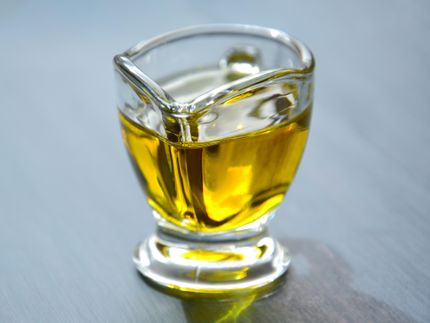Bread distillery: Bioethanol from the bakery
This is bioeconomy at its best: pilot plant produces alcohol from old baked goods
The bakery of the future not only smells of delicious bread - it also smells of alcohol. This has been made possible by a pilot project with the University of Hohenheim in Stuttgart: Germany's first bread distillery has gone into operation at the Webers Backstube bakery in Friedrichshafen. This ensures greater sustainability: old baked goods that can no longer be used as food are turned into bioethanol for industrial purposes. In the long term, it should also be possible for tasty "bread spirits" to enrich the bakery's product range. The bread distillery was officially opened on February 23, 2024.

Bioeconomy at its best: The University of Hohenheim and Webers Backstube have commissioned a pilot plant in Friedrichshafen for the production of bioethanol from old baked goods
Lukas Müller
Baked goods are among the most frequently thrown away foods. There are around 11,000 predominantly small and medium-sized bakeries in Germany, which produce an estimated 600,000 tons of baked goods as returns and leftovers every year.
Many bakeries try to reuse these products: as animal feed, wood chips or in biogas plants. "However, returns are not a uniform source material. This is not compatible with the strict feeding schedules in pig fattening, for example," explains Hannes Weber, Managing Director of Weber's Backstube, known as a TV baker from SWR television and initiator of the "Die Brotbrennerei" project. "These recycling methods are therefore associated with time-consuming manual sorting, long transportation routes and therefore additional costs."
Bakery businesses have to dispose of old baked goods as waste
Many bakery businesses therefore have to dispose of their old baked goods as waste, which is usually incinerated. Weber's bakery alone incurs annual disposal costs of around 15,000 euros. His idea: why not turn the waste into bioethanol? In future, an estimated 162 million liters could be produced annually from old baked goods in Germany.
The aim is to create a renewable fuel source. To date, bioethanol has primarily been produced from agricultural crops such as maize, wheat and sugar cane. However, the use of these plants as raw materials for fuel production competes with the production of food.
The long road from bread to alcohol
The research and training distillery at the University of Hohenheim first clarified a fundamental question: can bread be fermented at all? This is because the production of bioethanol requires an alcoholic base.
For this so-called mash, grain is mixed with water, yeast and enzymes. "Bread contains considerable amounts of starch. It is easily broken down into sugar molecules by special enzymes, which the yeast then converts into alcohol," explains Dr. Daniel Einfalt from the Research and Teaching Distillery.
Yeast needs proteins
However, the process was not quite so simple. When the researchers investigated how well typical German bakery scraps could be fermented, they were in for a surprise: of all things, the bread with the highest starch content, white bread, was significantly lower in alcohol production than other starting products such as bread rolls, pretzels, rye bread or cream cakes.
"We attribute this to the low protein content of white bread," says Dr. Einfalt. "Because the protein building blocks are essential for the activity of the yeast." This is remedied by adding fermentation salts, which provide the yeast with nitrogen and phosphate in particular: this shortens the fermentation time and increases the ethanol yield.
Nevertheless, there is still a lot of protein in the distillation residue, the stillage. "In the long term, we would like to use it as animal feed, but we still have a few hurdles to overcome," says Hannes Weber. "It is currently used in biogas plants to generate energy. Its residue is then used as fertilizer in the fields." Which closes the cycle.
Optimization of the entire process
In order to put the ideas into practice, another project partner came into play: the Technology Transfer Centre Bremerhaven (ttz Bremerhaven) developed its own energy concept. The heat for the process is primarily provided by electricity from the photovoltaic system on the roof of the bakery. As much heat as possible is recovered within the process, for example from the stillage or from the cooling water of the distillery.
"It was far more difficult to find a plant manufacturer," reports Hannes Weber. "We are delighted to have found Müller Brennereianlagen, who tailored the equipment and distillery technology to the project and provided a lot of input."
Current: Cost-covering operation - Long-term: Spirits as additional income
The bread distillery in Friedrichshafen is currently operating at break-even with its 2,000-liter mash tun, even though the market prices for bioethanol are currently low. The distillation of old baked goods could generate higher revenues if aromatic spirits for human consumption are produced from them.
"At the moment, this is still being thwarted by EU law," explains Dr. Einfalt. "It does not provide for the distillation of bread and other baked goods. But the legislative process is already underway."
Consulting services - pilot project for SMEs
The bread distillery in Friedrichshafen is still a pilot project that should be emulated as much as possible. To this end, the project participants are developing recommendations for action that they want to offer as consulting and development services for future operators of such production facilities. Hannes Weber estimates that such systems are profitable for medium-sized companies with an annual turnover of around five million euros. The project is funded by the Central Innovation Program for SMEs (ZIM) of the Federal Ministry of Economics and Climate Protection (BMWK).
Note: This article has been translated using a computer system without human intervention. LUMITOS offers these automatic translations to present a wider range of current news. Since this article has been translated with automatic translation, it is possible that it contains errors in vocabulary, syntax or grammar. The original article in German can be found here.




























































